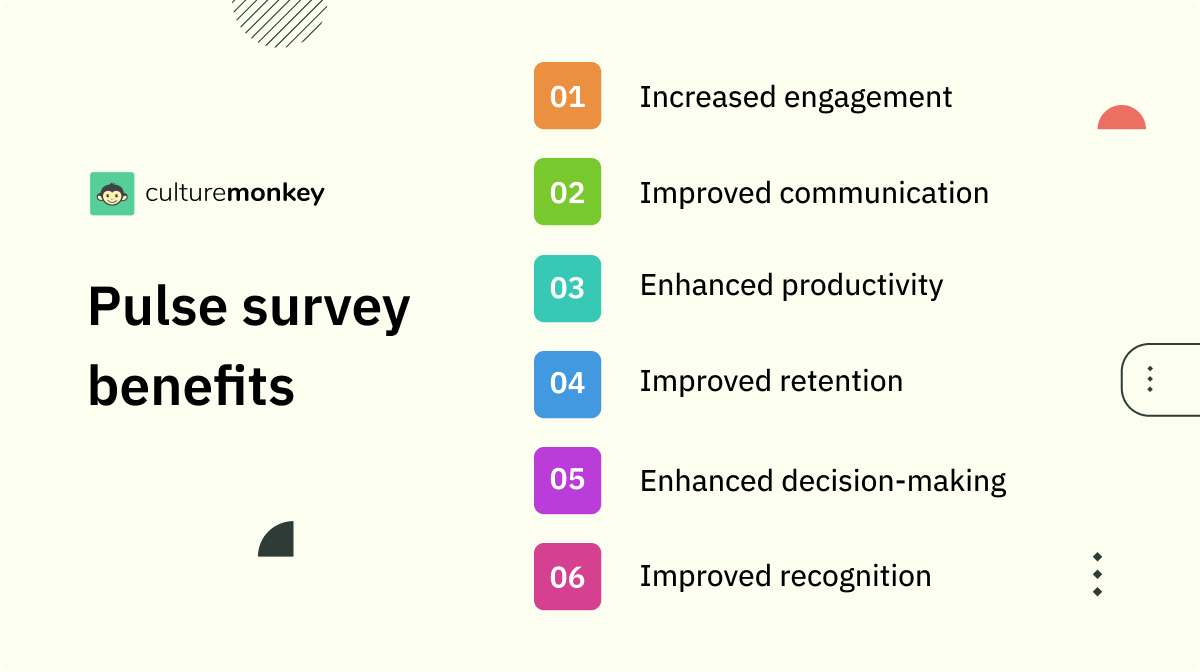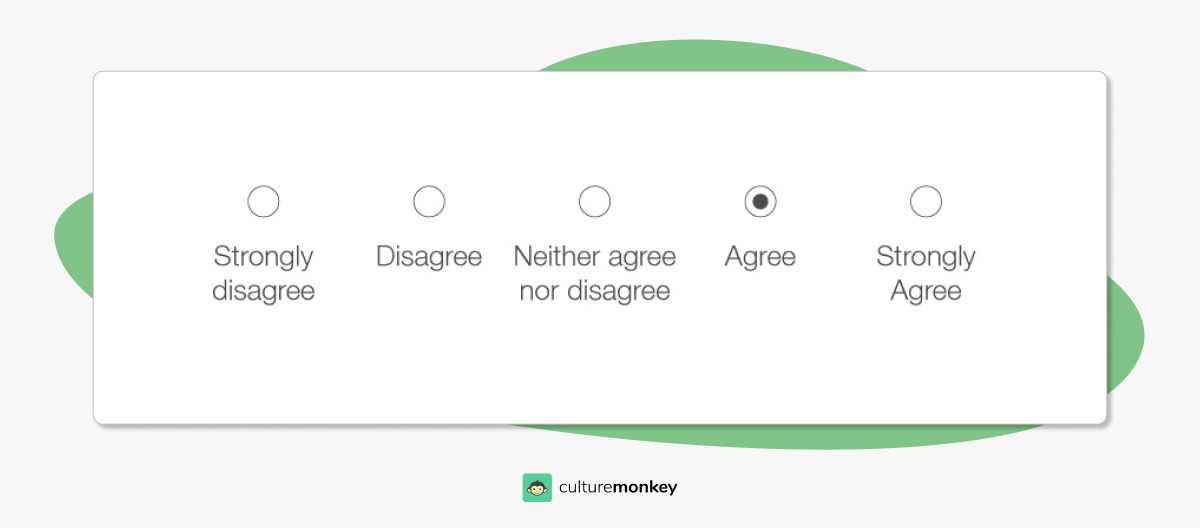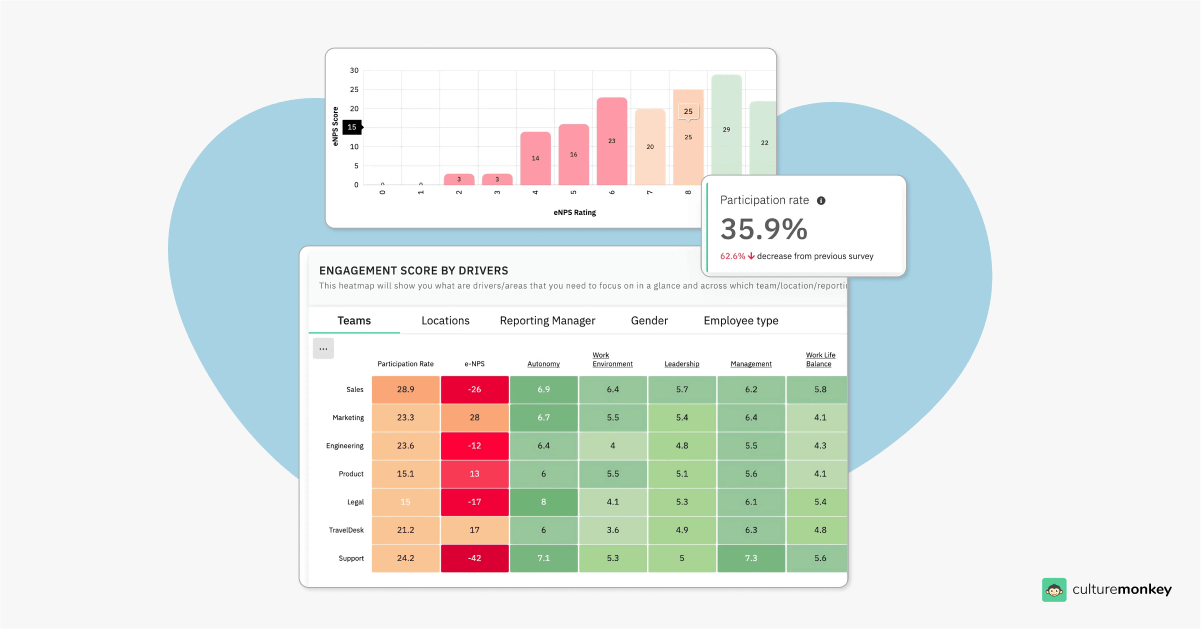150+ employee pulse survey questions you should be asking your employees in 2025

Gauge the mood of your employees with a pulse survey.
Remote or hybrid work is the new normal and organizations are embracing this new reality - some gladly and some, rather reluctantly.
Companies have also realized that during tough times, it is an engaged workforce - employees who are ready to go the extra mile for an organization - that can sustain the company and its operations.
One of the hygiene practices of employee engagement is to frequently listen to the needs of your employees, analyze their feedback, and proactively act on it.
Might sound easy but it is far from it.
Most organizations run employee engagement surveys annually. These year-on-year health report of your organization’s employee engagement levels, however, could be failing you on multiple fronts.
- Employees have to wait for annual surveys to voice their concerns and opinions. The long wait is enough time for an employee to go from being engaged to disengaged and ultimately, quit the organization.
- If the survey has a large number of questions, your employees are bound to feel overwhelmed or might end up not participating at all!
- Receiving a lot of feedback at one time of the year will leave the organization and the HR trapped under piles of issues to be resolved on priority.
What can help the situation?
See how employee pulse survey would look like in CultureMonkey's employee survey tool.
Table of contents:-
- What is a pulse survey?
- Pulse survey best practices For 2025
- How to choose questions for pulse surveys?
- Pulse survey benefits
- A guide to structuring your pulse surveys
- How long should my pulse survey be?
- What makes pulse survey more effective?
- How can you get the most out of pulse surveys for your company?
- What can pulse surveys measure?
- Pulse survey vs engagement survey
- When to switch to pulse check survey questions
- How to interpret employee pulse survey responses?
- How often should you run pulse surveys for your employees?
- How we choose our best employee pulse survey questions
- 150+ Pulse survey questions that deserve a place in your employee survey
- Common mistakes HR leaders make with pulse survey questions
- The role of technology in conducting employee pulse surveys
- Take the guesswork out of creating pulse surveys with CultureMonkey
- Conclusion
- FAQs
What is a pulse survey?

Just as the term ‘pulse’ suggests, pulse surveys are short, quick surveys carried out at frequent intervals, with a minimum number of questions that could garner better responses to assess your employees' engagement levels.
Employee pulse surveys help you in reducing respondent fatigue by measuring the engagement levels of your employees more regularly and with fewer questions. The primary objective of a pulse survey is to give you visibility into what your employees are thinking and feeling, and enables you to take swifter actions to resolve employee issues; without having to wait on the annual survey results.
How to choose questions for pulse surveys?

Let’s be honest, there is no one way of doing this, but there definitely is a process you can follow.
When it comes to strategizing your employee pulse survey questions, first, decide the objective of your survey. You might want to check your employees' reactions to the recent change in your HR policy, or you may want to do a post-appraisal pulse check, or even keep a tab on your employees' well-being during the pandemic.
Once the objective has been nailed down, put in place a proper structure for the employee survey. Eliminate any fluff and be direct when you are asking your employee pulse survey questions.
While setting up your employee pulse survey questions, be mindful of including crisp, direct questions that get actionable responses rather than routine long-form questions.
You can also include open-ended questions as a part of the survey, as this ensures that you get raw and unfiltered feedback, which can be analyzed to understand employee sentiments.
Even though open-ended questions are a great way to gather employee feedback, analyzing a large volume of subjective responses is not humanely possible. In that case, you could engage a people analytics platform to run the pulse survey questions.
CultureMonkey, for instance, will help you analyze the sentiments of your employee feedback in a matter of minutes, irrespective of the volume of anonymous feedback you receive. Not only that, its AI-based algorithm will give you actionable insights and personalized action recommendations based on employee feedback to enable you to increase employee engagement within your teams.
Pulse survey benefits

Employee pulse surveys are typically short, focused surveys that are conducted on a regular basis. Following pulse survey questions are a great way for employers to gain insight into their employees' feelings about their current work environment, processes, and policies.
The benefits of a pulse survey for employers are numerous. Here are a few of the most significant:
Increased employee engagement
Pulse surveys provide employers with an opportunity to get feedback from employees on a regular basis, which helps engaged employees in the organization. This helps employers create an environment where employees feel heard, valued, and respected.
Pulse surveys also allow employers to gauge morale and satisfaction levels, which can help them understand what changes they may need to make to keep employees motivated and satisfied.
Improved communication
Pulse feedback helps employers better understand their employees' needs and concerns. This allows employers to quickly address any issues that arise and make proactive changes that can improve internal communications. Pulse surveys can also help employers identify areas where they can better support employees and create a more positive work environment.
Enhanced productivity
Employee pulse surveys provide employers with real-time feedback, which can help identify areas where productivity could be improved. This allows employers to make timely changes that increase efficiency and get more out of their employees.
Improved employee retention
Pulse surveys can help employers identify areas where employees feel undervalued or unappreciated. This allows employers to make changes that can help retain employees and reduce turnover. Employee pulse survey questions also allow employers to show employees that their opinions are valued and that their feedback is taken seriously.



Appropriate pulse survey mechanisms increase the volume and timeliness of data and uncover issues that need immediate attention.
HR Analyst and Founder
Bersin by Deloitte
Enhanced decision-making
Pulse survey questions provide employers with real-time data that can be used to make informed decisions. By gathering feedback from employees on a regular basis, employers can gain insight into areas where they need to make changes or improvements. This allows employers to identify areas of opportunity and make strategic decisions that can help the company values.
Improved employee recognition
Employee pulse surveys provide leaders with an opportunity to recognize and reward employees for their efforts. By understanding employee needs and concerns, employers can create tailored recognition programs that make employees feel appreciated. This can help increase employee engagement and satisfaction and boost morale and productivity.
Improved employee performance
Pulse surveys can help employers identify areas where employees need additional support or training. This allows employers to provide employees with the necessary resources and tools to perform their best.
Pulse survey best practices For 2025
- Ask targeted, actionable questions: Tailor questions to address specific challenges or goals within the organization. By focusing on what matters most to employees and business outcomes, you gather insights that can be turned into concrete actions.
- Maintain the right survey cadence: Strike a balance between gathering regular feedback and minimizing survey fatigue. Bi-weekly or monthly surveys often provide timely insights while respecting employees’ time.
- Guarantee confidentiality: Anonymity builds trust, encouraging employees to provide honest and candid feedback without fear of repercussions. This allows leaders to access more authentic insights.
- Leverage advanced data analytics: Use AI and analytics tools to identify trends, spot emerging issues, and benchmark progress over time. Real-time data empowers leaders to make informed decisions and respond quickly to employee needs.
- Act on and communicate results: Show employees their feedback drives change. Share employee survey findings transparently, outline action plans, and consistently update employees on progress to build trust and engagement.
- Tailor questions to different teams: Adapt pulse surveys to reflect the unique needs, roles, and challenges of different teams or departments. This ensures all employee voices are heard and respected.
- Prioritize mental health and well-being: As workplace wellness remains a top priority, incorporate questions that assess stress, burnout, and work-life balance. Addressing well-being shows a commitment to holistic employee health.
- Optimize accessibility: Ensure surveys are mobile-friendly and easily accessible to all employees, including remote or deskless workers. Higher accessibility boosts participation and provides more comprehensive feedback.
A guide to structuring your pulse surveys
- Address specific topics: Structuring targeted questions allows for quick, meaningful insights. Topic examples include: job satisfaction, communication, employee well-being.
- Use a consistent response scale: A five-point Likert scale is commonly used, ranging from: “Strongly Disagree” to “Strongly Agree”. These consistent scales help quantify employee sentiment and enable nuanced feedback.

- Standardize data collection: Track changes and compare results over time with a standardized format. This enables easier data analysis and actionable insights.
- Incorporate open-ended questions occasionally: These questions help capture detailed employee perspectives for deeper context, providing a balanced approach to gathering both qualitative and quantitative feedback.
How long should my pulse survey be?
A good employee pulse survey should be short and to the point - typically no longer than 5 minutes. Make sure to ask survey questions that are relevant to the topic and easy to understand. It should include questions that measure satisfaction levels, engagement, and overall sentiment.
But the frequency of the pulse survey should directly influence the number of questions:
- Monthly: 10–15 questions
- Quarterly: 15–20 questions
- Bi-annual: 20–30 questions
Employee survey questions should be worded in a way that encourages open-ended responses. For example, ask, "How satisfied are you with the service you received?" instead of "Rate your satisfaction with the service you received."
The survey should also provide clear instructions on how to answer each question. Additionally, it should provide an option for respondents to leave comments or feedback at the end of the survey. Finally, the survey should include an opt-out option for respondents who do not wish to participate.
What makes pulse survey more effective?

Pulse surveys are an effective way of measuring employee engagement and satisfaction. They provide quick feedback on how employees are feeling and can be used to identify areas of improvement. Pulse survey questions are more effective than traditional surveys because they:
- Provide frequent feedback: These are conducted more frequently than traditional surveys, allowing organizations to get a better sense of how employees are feeling on a regular basis. This frequent feedback can help organizations identify problems and take action before they become more serious.
- Require less effort: This type of survey requires less effort from employees because they are shorter and more focused than traditional surveys. This makes them less intimidating and more likely to be completed.
- Focus on specific topics: Traditional surveys often ask a wide range of questions about different topics. However, pulse survey questions focus on specific topics that are designed to measure employee engagement on a particular topic. This makes it easier to analyze the results and identify areas of improvement.
- Access to real-time data: Pulse surveys allow organizations to access real-time data, which can be used to make rapid decisions. This data can be used to identify trends and adjust strategies quickly to improve employee engagement.
- Engage employees: Pulse surveys are an effective way to engage employees and show that their feedback is valued. Employees are more likely to respond to pulse survey questions if they feel that their input is taken seriously and can be used to improve the employee experience.
- Easy to analyze: Pulse surveys provide quantitative data that is easy to analyze. This data can be used to identify areas of improvement and develop strategies to improve employee engagement.
- Flexible: Pulse surveys can be adapted to different scenarios, allowing organizations to tailor them to their specific needs. This flexibility allows organizations to measure different aspects of employee engagement and satisfaction.
- Easy to deploy: Pulse surveys can be deployed quickly and easily, making them ideal for organizations that need to collect feedback quickly.
- Improved accuracy: Pulse surveys are designed to measure employee engagement on a specific topic, which makes the results more accurate than traditional surveys.
- Improved decision-making: Pulse surveys provide organizations with more data, which can be used to make better decisions and improve employee engagement.
How can you get the most out of pulse surveys for your company?
Pulse surveys are a great way to keep track of employee satisfaction, engagement, and productivity levels. They provide companies with valuable insights into what’s working and what’s not so they can make informed decisions and improvements.
Here are a few tips to help you get the most out of pulse surveys for your company.
- Ensure the questions are relevant: Pulse surveys should focus on specific topics relevant to your company’s goals and objectives. Consider what matters most to your organization and ensure the pulse survey questions you’re asking reflect that.
- Keep it simple: Don’t overload your employees with too many questions or long, confusing ones. Try to keep it simple and to the point.
- Offer anonymous feedback: Employees should feel comfortable providing honest feedback without fear of repercussions. Allow for anonymous feedback to ensure you’re getting truthful responses.
- Set a regular schedule: Try to set a regular schedule for your pulse surveys, so your employees know when to expect them. This will help ensure everyone is participating and that you’re getting up-to-date information.
- Follow up on results: Once you’ve collected the responses, it’s important to follow up and take action. Make sure to review the results and address any issues or concerns that have been raised.
What can pulse surveys measure?
Pulse survey has become a popular tool for employers to measure and assess their overall organization. Here are the top crucial factors that employers measure through pulse questions.
Employee engagement
Engagement measures how passionate and connected employees are to the organization and its mission. Pulse surveys allow employers to measure improved employee engagement levels over time and assess the impact of initiatives and changes on the organization. This data can help employers identify strategies to increase engagement and bolster employee morale.
Job satisfaction
Pulse surveys help employers understand what motivates employees in their roles and identify opportunities to improve job satisfaction. This data can help employers create an environment that is conducive to employee happiness and productivity.
Morale
Pulse surveys allow employers to assess employee morale over time and identify areas where morale could use a boost. This data can help employers create an engaging and supportive work environment for their employees.
Company culture
Company culture is the shared values, beliefs, and behaviors of the organization. Pulse surveys help employers assess the effectiveness of their culture and identify areas where they can improve, for example, the company's diversity and inclusion. This data can help employers create a culture that is supportive of their employees and their goals.
Job performance
Job performance measures how well employees are meeting their goals and expectations. Employee pulse surveys allow employers to assess job performance in order to identify areas of improvement and provide feedback to employees. This data can help employers ensure that their employees are performing at their best and meeting their goals.
Team dynamics
Employers measure team dynamics by asking pulse survey questions about collaboration, trust, team engagement and communication. These surveys can also be used to gauge how well team members are working together and if any improvements need to be made.
Workload
Pulse survey questions about work life balance, workload management, and job satisfaction can be asked. This helps to identify areas where workloads can be reduced or better managed.
Professional development
Pulse surveys can also measure employees’ career development. Questions can be asked about professional development opportunities, training, and meaningful recognition. These insights can be used to develop plans and initiatives to aid in employee development.
Communication
Pulse surveys can help employers measure how effectively they communicate with their employees. Pulse survey questions about communication methods, feedback, and communication channels can be asked. This information can be used to identify areas where internal communications can be improved.
Recognition
Pulse surveys can help employers measure the recognition level they provide to their employees. Questions can be asked about rewards, recognition, and appreciation. These insights can be used to create plans and initiatives to better recognize employees’ efforts.
Pulse survey vs engagement survey
Pulse surveys and engagement surveys are two of the most popular methods of collecting feedback from employees. The two surveys have their similarities but also their differences.
Pulse surveys are designed to provide more frequent feedback from employees than traditional engagement surveys. They use short and quick surveys that allow for quick answers from employees, usually weekly or bi-weekly.
This allows for collecting more timely feedback, allowing leaders to quickly adjust their processes and strategies. Pulse surveys are also often anonymous, which helps to create a more trusting environment where employees feel comfortable responding honestly.
On the other hand, the employee engagement survey is typically longer and more comprehensive surveys that measure employee attitudes and opinions on various workplace topics. These employee surveys provide deeper insights into employee engagement and satisfaction, allowing leaders to make more informed decisions.
Engagement surveys are also often conducted as quarterly or annual employee surveys, allowing leaders to track the progress of their engagement initiatives over time.
When it comes to the positives of each survey, both pulse surveys and annual employee surveys can provide valuable insights into employee attitudes. Pulse surveys are ideal for gaining quick feedback to help make more timely decisions, while engagement surveys provide more in-depth insights that can help leaders understand the overall health of their organization.

When to switch to pulse check survey questions
Pulse surveys are a strategic choice when instant feedback and timely responses are critical for your organization. Unlike traditional employee surveys, which are comprehensive but infrequent, pulse surveys offer focused, concise insights that can be gathered regularly.
This makes them ideal for tracking shifts in employee sentiment, monitoring the impact of new initiatives, and addressing challenges as they arise.
When organizations undergo significant change—such as mergers, leadership transitions, or new policy implementations—pulse surveys provide a mechanism to gauge employee reactions and adapt accordingly.
The agility of these surveys enables leaders to respond quickly to emerging trends and concerns, fostering a culture of transparency and continuous improvement.
By maintaining a consistent feedback loop, HR teams can proactively address morale, engagement, and productivity issues, strengthening the overall employee experience. If your goal is to keep a continuous "pulse" on how employees are feeling and reacting, pulse surveys are a valuable, actionable tool for staying in tune with organizational needs.
How to interpret employee pulse survey responses?
When interpreting employee pulse survey responses, it is important to look at both individual and collective responses. By looking at individual responses, employers can better understand the individual’s opinion of the company and their role.
This helps employers identify areas of improvement and address any issues that may negatively impact an employee experience.
In addition to looking at individual responses, employers should also look at collective responses. This will allow them to identify any common themes or trends in the responses that can be used to create a better work environment.
For example, if several employees reported a lack of recognition or appreciation for their work, the employer can take steps to ensure that employees are being recognized and rewarded appropriately.
When comparing individual responses to collective responses, looking at both the positive and the negative is important. While it may be tempting to focus solely on the positive aspects of the survey responses, it is also important to take note of any negative responses.
By taking the time to interpret employee pulse survey results, employers can gain a better understanding of their workforce and create a more supportive and engaging work environment. This will benefit employees and create a positive workplace culture that will help attract and retain quality talent.
How often should you run pulse surveys for your employees?

When it comes to pulse survey frequency, there is no one-size-fits-all approach. Even though it is essential to send surveys regularly, you should make sure that you are not sending them too frequently.
One way to determine the frequency of your surveys is to know how much time you would need to act on the feedback received.
Here’s an example.
Alex is an HR at a real estate project management company with 3700 employees. He sends well-drafted surveys to employees every second week and receives great appreciation from his manager for taking the initiative. However, over the course of time, Alex noticed a sharp decline in the response rate to the surveys.
What do you think happened?
Even though Alex was proactively asking for employee feedback, he failed to acknowledge the responses received. And employees who didn’t see their feedback being acted on slowly lost interest and stopped responding to the surveys that Alex was sending out with so much enthusiasm.
The point we are trying to make here is, chart out how much time your organization would take to run, analyze and act on employee feedback, and work backward to decide the frequency of your pulse surveys.
For sure, employee pulse surveys can get you quick feedback and results, but you need to be mindful of the fact that, it is your timely action on the feedback received that will ultimately determine the success of your survey mechanism.
However, to go through all the feedback, prioritize the more pressing ones, and act on them in a timely manner is a more tedious task than it sounds.
That's why we think you could do this with some professional help from pulse survey software.
For example, CultureMonkey provides you with a bottom-up feedback management system that not only lets you track the status of your employees’ feedback but also helps you in sending an acknowledgement to your employees once their feedback is resolved.
How we choose our best employee pulse survey questions
- Targeted questions: We focus on questions that are specific, actionable, and aligned with key engagement drivers, ensuring they offer meaningful insights without wasting employees' time.
- Focus areas: Our questions capture the pulse of the organization by measuring critical factors such as rewards, recognition, autonomy, and employee well-being. This ensures they address areas that matter most to both employees and leaders.
- Data-driven approach: We utilize industry benchmarks, research-based frameworks like Gallup’s Q12, and feedback from past surveys to refine our questions and maximize their relevance and clarity.
- Clear and measurable: Each question is designed to provide measurable data that can drive meaningful action and improvements within the organization.
- Fostering dialogue and engagement: Our questions aim to spark honest dialogue, boost engagement, and empower leaders with insights they can use to create a thriving workplace culture.
150+ Pulse survey questions that deserve a place in your employee survey
We have arranged our choice of employee pulse survey questions in such a way that it is easier for you to include them based on the employee engagement drivers you want to measure in your survey.
Rewards
- Do you believe that you are rewarded fairly for the work that you do?
- Do you feel that reward frequency is handled in the same way for every employee?
- Are there any other employee benefits you think that the business could offer which would make working here more valuable?
- How important do you think rewards are to motivate you to complete tasks?
- Do you think rewards should be tailored to the individual or be universal?
- Do you feel that the current reward system effectively acknowledges your contributions?
- Are you satisfied with how performance-based bonuses are distributed?
- Do you feel recognized for going above and beyond in your role?
- Are non-monetary rewards (e.g., flexible hours, time off) effective motivators for you?
- How transparent do you find the process of deciding rewards?
Recognition
- Do you feel valued and appreciated regularly by the business?
- Is the recognition you get from your manager meaningful enough?
- Do you have any recommendations on how the business can recognize employees more effectively?
- Do you feel supported by your colleagues and managers?
- How do you think recognition impacts morale and motivation in your team?
- How often do you receive recognition that feels sincere and personal?
- Is there a positive company culture of celebrating individual achievements?
- How often do you receive informal recognition from peers?
- Do you feel your contributions align with the organization's recognition criteria?
- What type of recognition would make you feel more valued?
Autonomy
- Do you feel you have enough autonomy over the way you do your work?
- Do you have the freedom to put your best foot forward?
- Do you feel that you need more responsibilities from your project/team?
- How often do you feel you can make decisions without a manager's approval?
- Do you feel you have the freedom to take risks in your work?
- Do you feel empowered to make decisions that impact your work?
- Are you encouraged to find innovative approaches to your work?
- Do you have enough control over your day-to-day schedule?
- How often are you trusted to work independently on key projects?
- Do you feel empowered to provide input in decision-making processes?
Growth & development
- Do you have enough opportunities to learn and develop new skills?
- Do you think your manager shows a genuine interest in your career goals?
- In terms of training and professional development, what would you like to see us offer to align with your career goals?
- How often do you take part in activities that help you grow and develop professionally?
- How satisfied are you with the current career growth and development opportunities you have access to?
- How effectively do the opportunities for growth align with your long-term career goals?
- Are there sufficient mentorship opportunities within the organization?
- How accessible are leadership training programs?
- Do you feel your skill development is prioritized by the company?
- What new skills would you like to develop in the next year?
Communication
- Does the leadership share necessary information about the company with employees?
- Do you have enough opportunities within the organization to voice your opinions and concerns?
- How can we further improve communication in our organization?
- How often do you feel you are given enough information to make decisions?
- How often do you feel that our communications are clear and concise?
- Do you feel that feedback is taken seriously and acted upon?
- Are your communication needs effectively supported by existing tools and platforms?
- How accessible is leadership when you have questions or concerns?
- Are you satisfied with the timeliness of company announcements?
- Do you feel feedback is acted upon consistently across all teams?
Management
- Do you find your manager supportive?
- Do you feel like the management team here is fostering a good work culture?
- What three words would you use to describe our culture?
- Is there anything you would like to see management do differently?
- Do you feel that management is accessible and approachable?
- How effectively does the management communicate expectations and goals?
- Does your manager take time to understand your unique challenges?
- Are managers receptive to constructive feedback from their team?
- How effectively does management create a sense of team unity?
- Are you regularly asked for input on team objectives?
Leadership
- Do you think our senior leaders are visible and reasonably accessible to employees?
- Does your manager communicate a clear picture of your team’s direction?
- What are the things you would change if given a leadership opportunity in your team?
- Are there any areas where you feel that our leadership team could improve?
- Do you feel that the leadership team allows for a healthy work-life balance?
- How confident are you in the leadership team's ability to guide the company successfully?
- Does senior leadership make decisions transparently?
- Are leaders willing to admit and learn from mistakes?
- Do leaders promote a strong ethical culture?
- How effective are leaders in communicating long-term strategies?
Involvement
- Do you have the resources and tools to contribute effectively at work?
- Are you frequently involved in the decision-making process related to your work?
- What measures can be taken to make you feel more involved in your role?
- How satisfied are you with your current level of involvement in the organization?
- Do you feel your opinions and ideas are valued within the organization?
- How often do you participate in meetings or discussions that impact your work?
- Do you have input into decisions that affect your role?
- Are cross-departmental collaborations encouraged and supported?
- How valued do you feel during strategic planning discussions?
- Is your feedback sought when new policies are introduced?
Innovation
- Are you frequently encouraged to come up with new ideas?
- Do you think your organization has a culture that is open to risk-taking?
- According to you, what would make it easier for you to contribute ideas?
- Are there any areas of innovation you would like to see us focus on most?
- How can we ensure our organization stays ahead of the curve in terms of innovation?
- How often are your innovative ideas implemented?
- Are you given time to explore new ideas and solutions?
- Do you feel innovation is rewarded within the company?
- How well does the organization foster a culture of experimentation?
- Is it safe to propose unconventional ideas?
Work environment
- Do you feel that the vibe of the workplace is positive and motivating?
- Do you have a comfortable space to work from home with good internet connectivity?
- Do you feel accepted and respected in the workplace? If not, how can we help you with that?
- Do you feel safe and secure in the work environment?
- Do you feel you have a good work-life balance in the work environment?
- How would you describe the overall atmosphere of your work environment?
- Are office amenities adequate for your work needs?
- How satisfied are you with the technology available for your tasks?
- Is there a supportive culture of inclusivity in your workplace?
- Do you have the flexibility to personalize your work environment?
Work-life balance
- Do you find your work schedule flexible enough to manage your family or personal life?
- Do you think we should offer mental health services, like stress and anxiety management classes, for our employees?
- What policies can we introduce to give you a better work-life balance?
- How often do you take time off during the week to relax or spend time with family/friends?
- Do you feel your work-life balance has improved since you began working for this company?
- How effective are our current policies in supporting your work-life balance?
- Does your role allow you to disconnect from work after hours?
- Are you able to take breaks when needed to maintain focus?
- How well does the organization respect personal commitments?
- Are you encouraged to use your allocated time off?
Wellness
- Do you think your workplace promotes a physically healthy lifestyle?
- Do you feel it is important to have a well-defined corporate wellness program in an organization?
- If you could wave a magic wand and add a mandatory wellness policy, what would that be?
- How do you rate your overall feeling of wellness?
- Do you have any emotional or physical health concerns that you would like to address?
- How satisfied are you with the mental health support provided by the company?
- How would you rate access to mental health support services?
- Does leadership encourage taking steps toward wellness goals?
- Are wellness initiatives tailored to diverse employee needs?
- How often are wellness-related events or workshops conducted?
e-NPS
- How likely are you to recommend this company to your friends and family?
- If you were offered the same job at another organization, how likely is it that you would stay?
- How satisfied are you working with us?
- Do you feel the company has your best interests in mind?
- How would you rate the overall benefits offered by the company?
- How likely are you to remain with the company for the next two years?
- How well do you think the company supports professional growth?
- Do you believe you are part of a collaborative and supportive team?
- Are you proud of the company’s role in the community?
- How would you rate the company’s commitment to employee success?
Purpose alignment
- Are you aware of how your work contributes to the overall vision of the organization?
- Are you happy with your current role relative to what was described to you?
- What do you think can be improved about our company’s CSR?
- How aligned are you with the purpose of our organization?
- Do you feel that our organization’s purpose is inspiring and motivating to you?
- How well do you understand the company's long-term goals?
- How often do you reflect on your role’s contribution to the company's goals?
- Is your work aligned with your long-term personal aspirations?
- How strongly do you identify with the company’s vision?
- Does leadership communicate how individual roles drive company purpose?
Meaningful work
- Do you feel like you are creating an impact with your work?
- Do your personal career goals align with the role assigned to you in the organization?
- What does meaningful work mean to you?
- Do you think that there are meaningful parts to your job?
- Does your work align with your own personal values and goals?
- How often do you find your work to be fulfilling and purposeful?
- Does your work challenge you in a meaningful way?
- How often do you feel genuinely excited about your work?
- Do you believe your role makes a tangible difference to organizational success?
- Are you empowered to take on work that aligns with your passions?
Change management pulse survey questions
- Do you understand why recent organizational changes were implemented?
- How effectively has leadership communicated upcoming changes?
- Do you feel supported by management during periods of change?
- Have recent changes positively or negatively affected your daily responsibilities?
- Are you given opportunities to provide input during change initiatives?
- Do you have the necessary resources to adapt to organizational changes?
- How confident are you in leadership's ability to manage change effectively?
- Do you feel involved in the decision-making process during changes?
- Have you received adequate training to handle new changes?
- How satisfied are you with the organization's approach to change management?
Open-ended employee engagement survey questions
- What aspects of your job motivate you the most?
- How can the organization enhance your engagement at work?
- What suggestions do you have for improving internal communication?
- What do you find most satisfying about your current role?
- What additional support would help you achieve your career goals?
- Are there any tools or resources that would improve your performance?
- How would you describe the company's culture, and what changes would you recommend?
- In what ways can leadership better support your work and well-being?
- What changes in the work environment would enhance your job satisfaction?
- Is there anything else you'd like to share to help us improve your work experience?

Find the Right Pulse with the Right Questions
Download our guide to ask the right questions, drive meaningful employee engagement, and to make your employees feel heard.
Common mistakes HR leaders make with pulse survey questions
- Asking vague or irrelevant questions: Broad questions lead to unclear responses that are hard to act on. Focus on specific, targeted questions that address relevant issues and align with business goals for actionable insights.
- Overloading the survey: Too many questions lead to fatigue and lower response rates. Keep surveys concise—typically 5-15 questions—to respect employees' time and boost engagement.
- Ignoring follow-up actions: Gathering feedback without visible follow-up erodes trust. Communicate your action plan and provide regular updates to show employees their input drives meaningful change.
- Not ensuring anonymity: Lack of anonymity discourages candid feedback. Use anonymous platforms and reassure respondents of their privacy to foster open, honest responses.
- Using a "one-size-fits-all" approach: Tailor questions to different teams or roles to capture more relevant insights. Avoid generic questions that miss unique employee needs.
- Failing to track trends: Treat pulse surveys as ongoing tools to analyze trends over time, measure the impact of initiatives, and proactively address issues.
- Relying only on quantitative questions: Combine fixed-scale and open-ended questions to capture both measurable data and nuanced feedback for richer insights.
- Lack of purpose communication: Clearly explain the purpose of surveys and how results will drive change. This increases engagement and fosters a sense of ownership.
- Surveying too often or infrequently: Balance the frequency of surveys to avoid fatigue while ensuring timely feedback. Monthly or quarterly surveys typically work best.
- Overlooking inclusivity: Ensure questions are inclusive and culturally sensitive, capturing diverse perspectives and addressing different employee needs.
The role of technology in conducting employee pulse surveys
- Automated deployment: Technology enables automated scheduling and deployment of surveys, ensuring consistent and timely feedback collection without manual intervention.

- Advanced analytics: AI-driven tools such as CultureMonkey analyze survey data to uncover trends, predict engagement issues, and benchmark results, providing actionable insights.
- Real-time feedback: Real-time dashboards offer instant access to employee sentiment, allowing leaders to respond quickly and demonstrate active listening.
- Customizable surveys: Adaptive survey platforms tailor questions based on roles or previous responses, ensuring relevance and boosting engagement.
- Mobile accessibility: Mobile-friendly surveys engage remote and hybrid employees, enhancing participation and capturing diverse feedback.
- Data security and anonymity: Modern tools ensure data protection and anonymity, fostering trust and candid responses.
- HR system integration: Integrating survey data with other HR systems provides a holistic view of employee sentiment alongside key metrics.
- AI sentiment analysis: AI categorizes open-ended responses and qualitative data, detecting sentiment trends and key themes for deeper understanding.
- Actionable recommendations: Automated recommendations and follow-up tools enable immediate, meaningful action based on survey results.
- Scalability and customization: Technology allows scalable solutions tailored to diverse employee groups and organizational needs.
Take the guesswork out of creating pulse surveys with CultureMonkey
CultureMonkey's employee engagement platform is designed to take the guesswork out of creating pulse surveys. Our platform provides powerful analytics to help you better understand your employees and their engagement levels.
With our easy-to-use dashboard, you can quickly create employee surveys tailored to your organization's needs. You can also find real-time data into trends and actionable insights to help you make informed decisions.
We provide comprehensive reporting, so you can track progress over time and ensure your organization is on the right path. Our platform also enables you to easily collaborate with colleagues, so you can make sure everyone is on the same page.
CultureMonkey's pulse survey tool guarantees full secrecy and privacy for all employee interactions. Our GDPR-compliant tool allows employees to share their thoughts through pulse surveys and provides complete security for all employee responses. Additionally, a chat feature within the platform allows employers to anonymously address employees' feedback.
Conclusion
Irrespective of the year, pulse surveys will remain an indispensable tool for fostering an engaged and motivated workforce, especially as remote and hybrid work continues to shape organizational culture.
By focusing on targeted, actionable questions, maintaining consistent feedback loops, and leveraging advanced analytics, HR leaders can drive meaningful change, improve employee satisfaction, and enhance workplace productivity.
Remember, pulse surveys are only as effective as the actions taken based on the insights they provide. By actively listening, responding, and adapting, organizations can create an environment where employees feel heard, valued, and empowered to excel.
Implementing the best practices and continuously evolving your pulse surveys will ensure a thriving, resilient, and adaptable workplace culture. Take the pulse of your workforce often and let it guide your journey toward employee engagement excellence.
Summary
Pulse surveys are quick, regular check-ins that help organizations understand employee sentiment and engagement. Unlike traditional surveys, pulse surveys provide real-time feedback on key areas like leadership, recognition, and well-being, allowing for timely, targeted actions.
By leveraging concise questions and consistent feedback loops, companies can foster a culture of trust, transparency, and continuous improvement.
FAQs
1.What is the ideal response rate for a pulse survey?
An ideal response rate for a pulse survey is typically around 70% or higher, reflecting strong engagement and trust in the process. Lower rates may indicate survey fatigue or relevance issues. To achieve high participation, maintain concise surveys, emphasize anonymity, and visibly act on feedback to demonstrate that employee input leads to tangible workplace improvements.
2. What are some examples of pulse surveys tailored for remote teams?
Remote team pulse surveys can include questions on communication clarity, feelings of isolation, work-life balance, access to resources, and team collaboration. These targeted questions help gauge remote employees' needs, engagement levels, and areas for improvement, providing insights that drive supportive initiatives, foster connection, and align remote work with overall organizational objectives.
3. Do pulse surveys need to be tailored for different departments?
Yes, tailoring pulse surveys for different departments enhances relevance and response quality. Each department has unique roles, challenges, and dynamics, so customizing questions ensures accurate insights and actionable feedback. Department-specific surveys foster higher engagement by addressing distinct needs, improving targeted interventions, and enhancing overall employee satisfaction and productivity across the organization.
4. Can pulse surveys replace traditional engagement surveys?
Pulse surveys complement but do not fully replace traditional engagement surveys. While traditional surveys provide comprehensive, periodic insights into overall engagement, pulse surveys deliver frequent, real-time feedback on specific issues. Combining both allows organizations to address immediate needs and long-term trends, creating a balanced approach to measuring and improving employee sentiment and engagement.
5. How do I ensure pulse surveys are actionable?
Tailor pulse surveys to reflect current organizational needs, using focused questions that yield actionable data. Analyze results comprehensively and prioritize follow-through on key findings. Sharing outcomes and progress with employees reinforces commitment, demonstrating a closed feedback loop that transforms insights into tangible improvements and drives long-term engagement.




